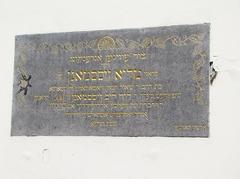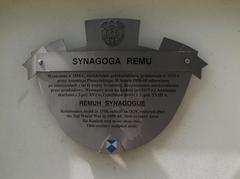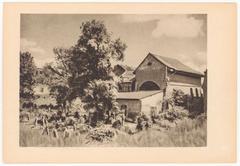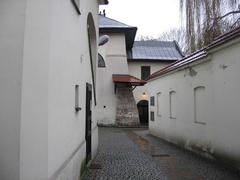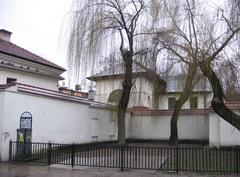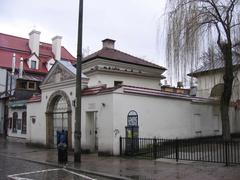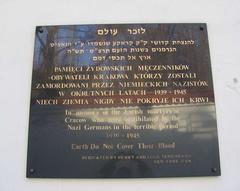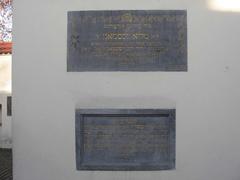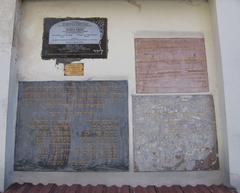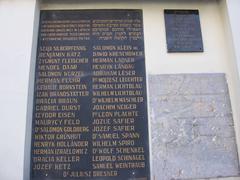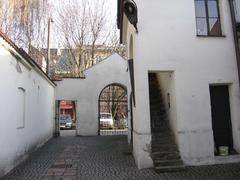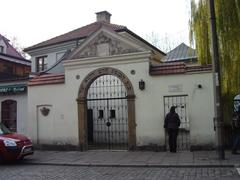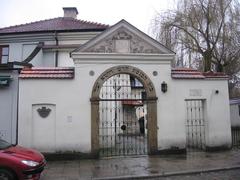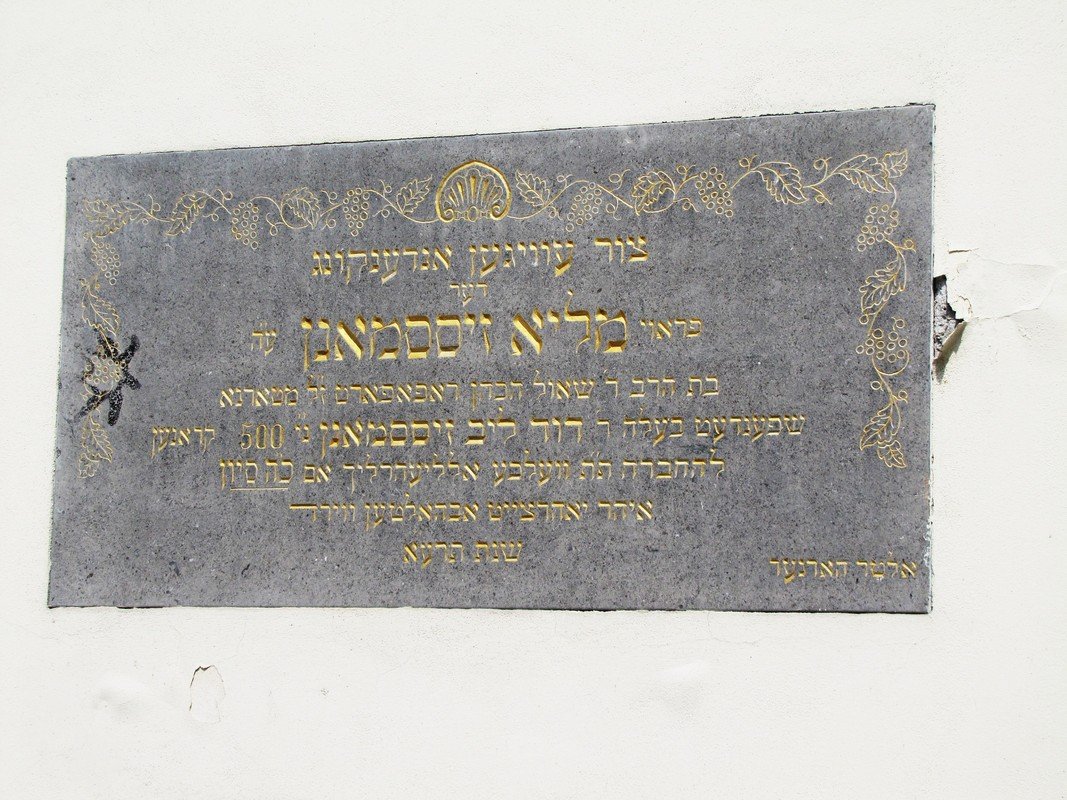
Remuh Synagogue Krakow: Visiting Hours, Tickets, and Historical Significance
Date: 14/06/2025
Introduction
Nestled in the heart of Kraków’s historic Kazimierz district, the Remuh Synagogue stands as one of Poland’s oldest and most significant Jewish religious sites. Founded in 1553 by Isserl ben Josef as a place of worship for his son, Rabbi Moses Isserles—known by the acronym “Remuh”—this synagogue embodies centuries of Jewish heritage, scholarship, and resilience (krakow.travel; ITS Poland). Its Renaissance architecture, serene interior, and the adjacent Remuh Cemetery, which houses the grave of Rabbi Isserles, offer a profound insight into Kraków’s vibrant Jewish history.
Despite enduring fires, wartime desecration, and periods of neglect, the Remuh Synagogue remains an active Orthodox house of worship and a poignant symbol of continuity within the Jewish community (Synagogues360; Zabytki Krakowa). Today, it serves both pilgrims and history enthusiasts, anchoring the Kazimierz district’s tapestry of synagogues, museums, and bustling local life.
This guide provides essential visitor information—up-to-date visiting hours, ticketing details, accessibility, and travel tips—while also exploring the synagogue’s architectural and historical highlights. Whether your interest is spiritual, historical, or cultural, the Remuh Synagogue offers a meaningful window into Jewish heritage and Kraków’s multicultural legacy (Karnet Krakow Culture; GetYourGuide).
Table of Contents
- History and Origins
- Architectural Highlights
- The Remuh Cemetery
- Visiting Guidelines
- Travel Tips and Nearby Attractions
- Visual Media and Resources
- Frequently Asked Questions (FAQ)
- Summary and Recommendations
- References
History and Origins
Founded in 1553, the Remuh Synagogue owes its name to Rabbi Moses Isserles (Remuh), a preeminent Jewish scholar and author of the “Mappa,” a foundational codex of Ashkenazi Jewish law (Wikipedia). The synagogue began as a private prayer house, built by Isserl ben Josef for his son, and was later expanded to serve the growing Jewish community of Kazimierz. After a fire in 1557, the original wooden structure was replaced by the stone building still standing today, designed in the Renaissance style by architect Stanisław Baranek (krakow.travel; Wikipedia).
Over centuries, the Remuh Synagogue has survived fires, Nazi desecration during World War II, and periods of neglect under communist rule. Restoration efforts, especially after the war, have preserved its role as both a spiritual center and a living monument to Kraków’s Jewish history (Synagogues360; Zabytki Krakowa).
Architectural Highlights
Exterior
The synagogue’s modest, rectangular stone structure reflects its Renaissance origins and contrasts with the more ornate synagogues nearby (Travel Curious). Stone buttresses support the walls, while the entrance on Szeroka Street features a gate with Hebrew inscriptions. The courtyard contains commemorative plaques honoring Kraków’s Jewish community and Holocaust victims.
Interior
- Sanctuary: Bright and welcoming, the sanctuary features white limestone walls, large windows, and twelve ornate chandeliers.
- Bimah: The elevated reading platform is encased in an 18th-century wrought-iron gate, topped with a gilded menorah bas-relief.
- Aron Kodesh (Torah Ark): Dating from 1558, this carved Renaissance ark is adorned with a richly embroidered Torah curtain.
- Memorial Elements: The synagogue interior and courtyard include inscriptions and memorials dedicated to the victims of the Holocaust and the resilience of Kraków’s Jewish community.
The women’s section, separated by arcaded openings, features 20th-century wall paintings depicting Jewish sites such as the Wailing Wall, Rachel’s Tomb, and Noah’s Ark (Zabytki Krakowa).
The Remuh Cemetery
Adjacent to the synagogue, the Remuh Cemetery is one of Poland’s oldest Jewish cemeteries, founded in 1551. It is the final resting place of Rabbi Moses Isserles, whose grave remains a site of pilgrimage, with visitors leaving prayer notes seeking his intercession (worldjewishtravel.org; giltravel.com).
Though closed in the early 19th century and desecrated during the Nazi occupation, restoration efforts have recovered and re-erected many tombstones. A poignant “wailing wall” made from fragments of destroyed headstones stands as a powerful memorial to the losses suffered by the community (sacred-destinations.com; jewishkrakow.net).
Visiting Guidelines
Visiting Hours
- Monday to Thursday: 9:00 a.m. – 4:00 p.m.
- Friday: 9:00 a.m. – 5:00 p.m.
- Saturday and Jewish holidays: Closed to tourists
Visiting hours may change during Jewish holidays and special events. Always check current schedules before your visit (Krakow Info).
Tickets and Entry Fees
- Standard ticket: 5 PLN per person (as of 2025)
- Purchase: Tickets are available at the entrance. Group rates and guided tours can be arranged via local operators (Tiqets).
Admission is free for worshippers during prayer times.
Dress Code and Etiquette
- Head covering: Men must wear a kippah or yarmulke (available at the entrance or bring your own). Women are advised to cover their heads during services.
- Modest attire: Shoulders and knees should be covered; sleeveless tops and shorts are not permitted.
- Photography: Permitted in designated areas; always ask permission and observe posted restrictions.
- Silence and respect: Maintain a quiet atmosphere; silence mobile devices and refrain from eating or drinking inside.
Accessibility
Due to the building’s historic nature, wheelchair access is limited. The entrance and some interior areas have steps and uneven surfaces. Visitors with mobility needs should contact the synagogue or tour operators in advance to arrange accommodations.
Guided Tours
Guided tours, available through local tour companies or the synagogue’s visitor center, provide deeper context on history, architecture, and Jewish traditions. Self-guided visits are supported by multilingual informational plaques (GetYourGuide).
Travel Tips and Nearby Attractions
- Location: 40 Szeroka Street, Kazimierz, Kraków—easily accessible on foot from the Old Town or by public transport.
- Best visiting times: Weekday mornings are generally quieter; Fridays close earlier for Shabbat preparations.
- Nearby attractions: The Old Synagogue (Jewish history museum), Tempel Synagogue, Galicia Jewish Museum, and vibrant cafés and shops of Kazimierz (Krakow Info; GetYourGuide).
- Security: Bag checks may be conducted; keep valuables secure during busy periods.
Visual Media and Resources
Virtual tours and high-quality images can be found on the Synagogues360 website.
Frequently Asked Questions (FAQ)
What are the Remuh Synagogue visiting hours?
Monday to Friday, generally 9:00 a.m. to 4:00 p.m. (Friday until 5:00 p.m.); closed on Saturdays and Jewish holidays.
How much are tickets and where can they be purchased?
Standard tickets are 5 PLN, available at the entrance. Group and guided tour rates vary.
Is the synagogue wheelchair accessible?
Partial access; some steps and uneven surfaces due to the historic architecture.
Are guided tours available?
Yes, through local tour providers and the synagogue’s visitor center.
Can I visit the Remuh Cemetery?
Yes, admission to the cemetery is included with your synagogue ticket. Head covering is required.
Can I take photos inside?
Photography is allowed in permitted areas; always ask staff and respect restrictions.
Summary and Recommendations
The Remuh Synagogue is a living monument to Kraków’s Jewish heritage, offering visitors a unique blend of history, architecture, and spiritual tradition. Located in the lively Kazimierz district, it is an essential stop for anyone interested in Jewish culture or Kraków’s historical sites. Plan ahead by checking visiting hours and ticket options, respect the dress code and etiquette, and consider joining a guided tour for the richest experience.
For more detailed guides and the latest updates, download the Audiala app, explore our related articles, and follow us on social media.
